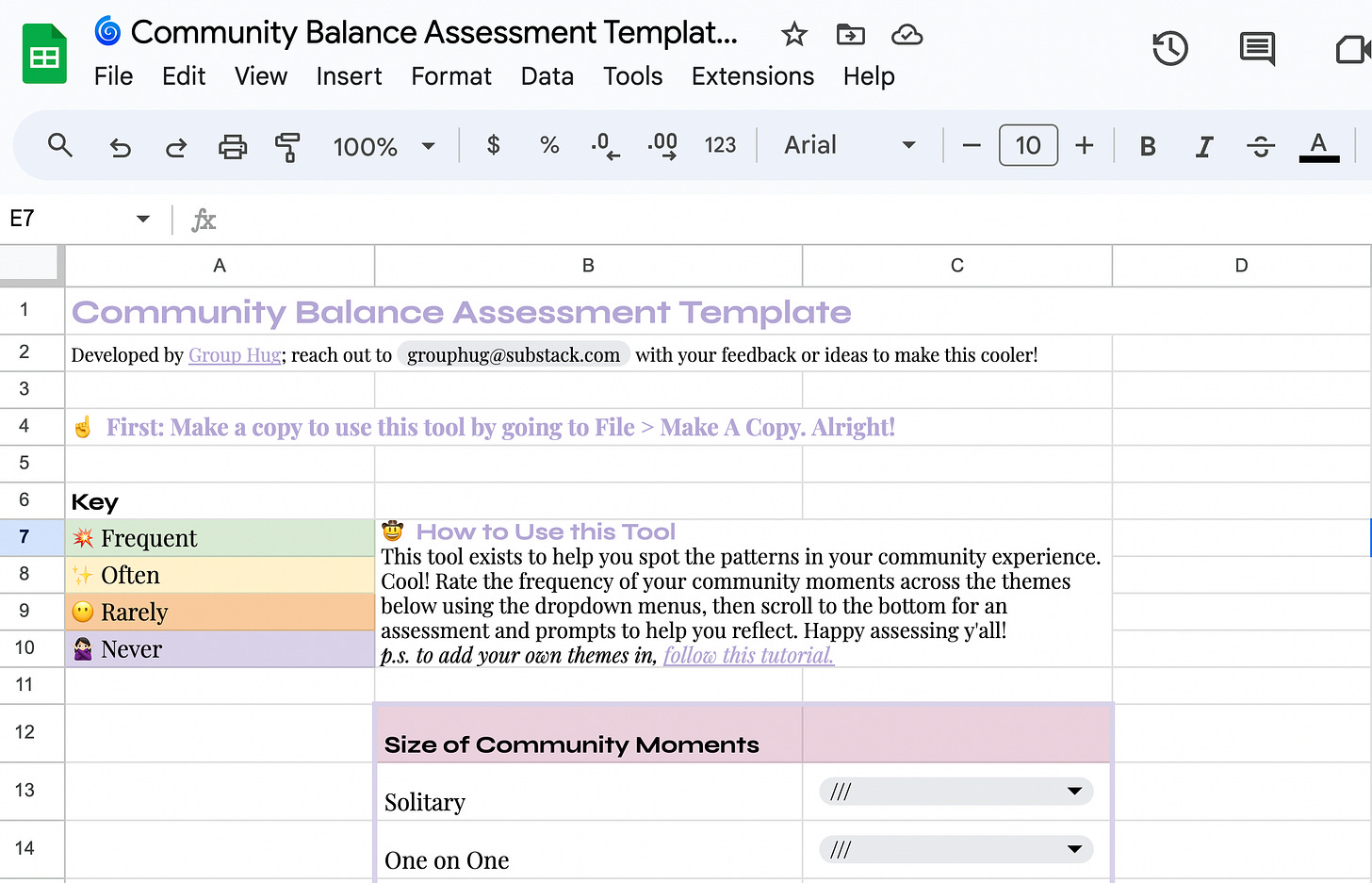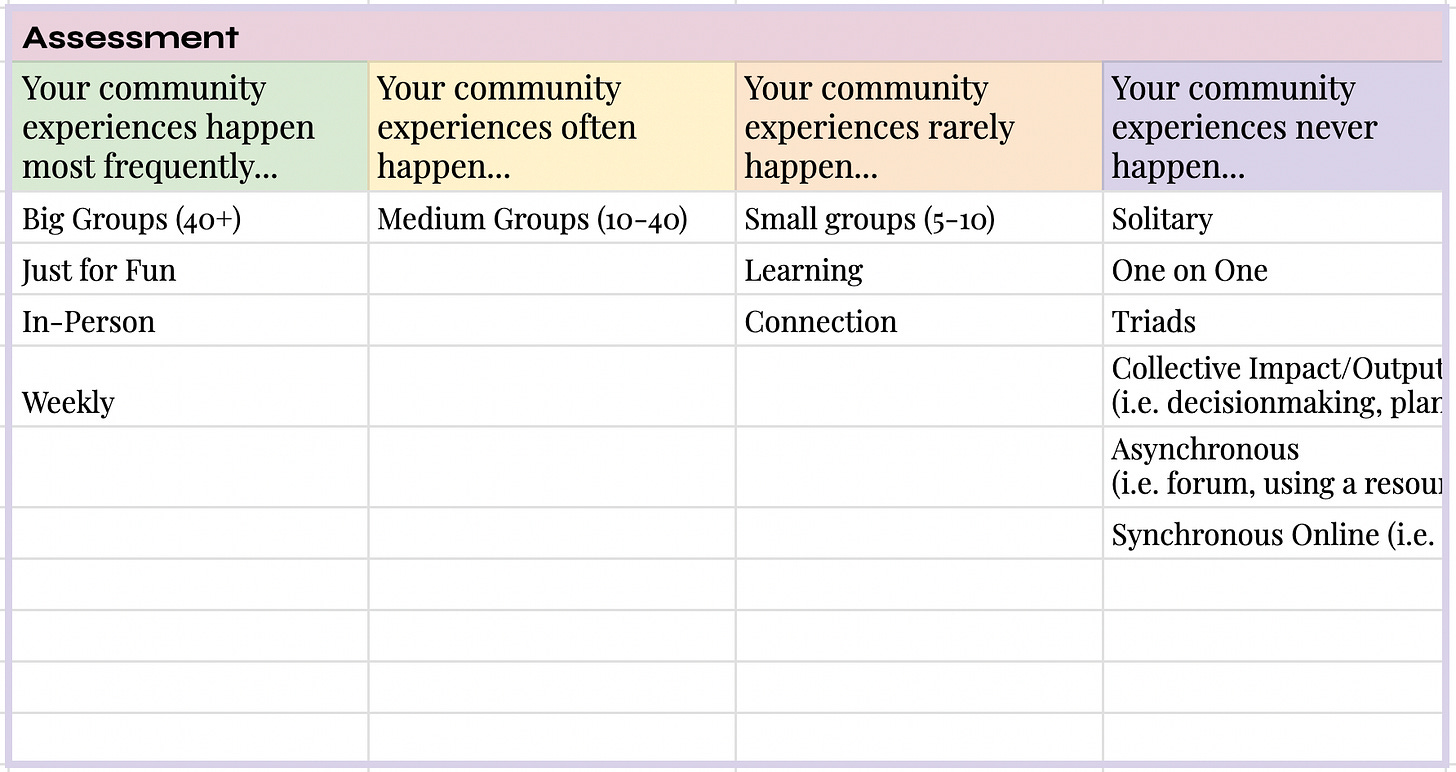Community Balance Assessment
Free tool! If the vibes feel off, maybe this is why?
✨ Thank you for joining the community craft conga line that is GROUP HUG. So glad you are here. ✨
Growing up, I was shamelessly obsessed with church. It was a “community church”, vaguely Protestant without it ever being articulated, every Biblical lesson tucked quietly behind the rock band (pastor’s wife on vocals giving Stevie Nicks), moralizing performance (I would stay up late on Saturday nights memorizing my lines), and weekly sermon drenched in metaphor (overloaded computer harddrive? A lot like our brains if we aren’t prioritizing Jesus Christ!)
In the tradition of billions of 16-year-olds who also just watched Fight Club before me, I eventually snuck out a side door and never went back, but it doesn’t mean I don’t long for the ease of that experience of other people more days than not.
It just felt easy and good and balanced. Even as a ten-year-old, I had solid friendships with other kids my age, knew the too-cool teens had my back, and had a rotation of sage adults and elders mentoring me.
In an environment that could have easily been defined just by its relationship to a single power figure – with either the pastor or, you know, god – there was an incredible amount of meaning placed in one another. Sure, god was in everything, the inevitable punchline to every story or innocent pizza night, but the interlocking networks of friendships, mentorships, and support felt like the headline. It was why I felt as shameless as I did; my love of church wasn’t just about belief. It was about the people.
Part of that secret sauce, when I think back on it now with my Community Craft Goggles™ (licensing pending), was in the balance. There was our weekly ritual of coming to listen to a sermon from the same guy, sure, but so much else happened in the meantime.
Here were a few of the many ways we came together:
Small Groups. Five or six people meeting in each other’s homes over instant coffee and the same text to interpret and chat over.
Elder Decisionmakers. A council of older, more tenured people in the church met to discuss and advise programs, spending, vibes, etc.
Volunteering. It was an unspoken expectation that at some point, everybody should sign up to usher, or set up morning coffee, or be a greeter.
A Silly Little Moment in the Sermon Where You Were Asked to Say Good Morning to Two People Near You. I still remember the feeling, after sitting transfixed watching a single person speak for fifteen minutes, where my attention opened up and realized there were other kind people sitting next to me and then I met them and felt the glee of meeting a nice stranger.
Many Food-Based Parties. My mom headed up the efforts for these all-out gatherings where we’d all come together as a congregation and go nuts and stuff our faces. Potato Picnics. Ice Cream Sundae Days. Pie Nights. We would get to keep many of the leftover pies and it was the best two days of my young pie-eating life.
Groups of people, like any ecosystem or very good stew (I might be hungry), thrive when there’s an intentional variety in the ways we come together.
It’s when we overindex on any one activity or type of gathering where things fray. Sometimes all you need to disrupt a top-down power dynamic is a different structure, but often the challenges might be more systemic, entrenched, and lopsided. They might be built into the very fibers of your community rituals, unspoken but felt.
For example: in your running club, do you find that you feel great about your big group moments but don’t really know any one person that well?
Or is your workplace Zoom-fatigued out while still longing for more moments of collective fun?
Or is your organizing group feeling worn and overloaded with too many big group meetings about heavy decisionmaking?
Maybe it’s because your community activities are out of balance, or haven’t been looked at with intention in a while.
Community Balance Assessment Tool
When I’m getting that feeling, I find it most helpful to zoom out, reflect, and look at the patterns I notice. To help with that, I developed a scrappy little Community Balance Assessment Tool for us to play with.
💥 Open the tool and make a copy for yourself to use.
The tool prompts you to reflect across themes of:
Size of Community Moments - how many people gather when you gather?
Purpose - why are you in community? What’s your real outcome together?
Frequency - how often do your activities happen?
Medium - how do you come together – in-person, over Zoom?
…and ask you to reflect on how frequently each of these happen. As you fill out the tool, you’ll get an assessment at the bottom that can help you spot any emergent patterns.
So for example, thinking back to that running group where you might not have any solid one-on-one friendships:
You might find that it’s because, unsurprisingly, you’re always coming together in these big group moments every week. Looking at that ‘Never’ column, it might spark some cool ideas: what would be possible if you gathered in smaller groups to create some collective impact together, like doing a volunteer day at a local nonprofit? Or beginning a monthly one-on-one coaching session program to develop your running skills with a mentor?
Of course, variety doesn’t always = greatness. Maybe it’s super intentional that your community only meets once a year as a big group. It’s when we don’t reflect on this at all that our experiences might feel out of whack.
I’m so curious to hear how you use this tool, what you’d change, and what patterns it helps you see. If you want to add your own themes to measure, here’s a tutorial to help you add more.
Happy pondering!
What if you shared this with someone you want to add more community variety with?






